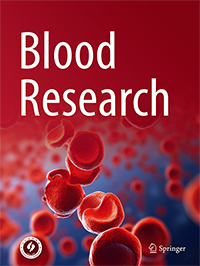Original Article
 Split Viewer
Split Viewer
Blood Res 2016; 51(3):
Published online September 23, 2016
https://doi.org/10.5045/br.2016.51.3.171
© The Korean Society of Hematology
Establishing the heparin therapeutic range using aPTT and anti-Xa measurements for monitoring unfractionated heparin therapy
1Department of Laboratory Medicine, Gyeongsang National University School of Medicine and Gyeongsang National University Hospital, Jinju, Korea.
2Department of Thoracic and Cardiovascular Surgery, Gyeongsang National University School of Medicine and Gyeongsang National University Hospital, Jinju, Korea.
3Institute of Health Sciences, Gyeongsang National University, Jinju, Korea.
Correspondence to : Correspondence to Eun-Ha Koh, M.D., Ph.D. Department of Laboratory Medicine, Gyeongsang National University Hospital, 79, Gangnam-ro, Jinju 52727, Korea. ehkohmd@gnu.ac.kr
This is an Open Access article distributed under the terms of the Creative Commons Attribution Non-Commercial License (http://creativecommons.org/licenses/by-nc/4.0) which permits unrestricted non-commercial use, distribution, and reproduction in any medium, provided the original work is properly cited.
Background
Unfractionated heparin (UFH) has unstable pharmacokinetics and requires close monitoring. The activated partial thromboplastin time (aPTT) test has been used to monitor UFH therapy for decades in Korea, but its results can be affected by numerous variables. We established an aPTT heparin therapeutic range (HTR) corresponding to therapeutic anti-Xa levels for continuous intravenous UFH administration, and used appropriate monitoring to determine if an adequate dose of UFH was applied.
Methods
A total of 134
Results
An aPTT range of 87.1 sec to 128.7 sec corresponded to anti-Xa levels of 0.3 IU/mL to 0.7 IU/mL for HTR under our laboratory conditions. Based on their anti-Xa levels, blood specimen distribution were as follows: less than 0.3 IU/mL, 65.7%; 0.3–0.7 IU/mL (therapeutic range), 33.6%; and more than 0.7 IU/mL, 0.7%. No evidence of recurring thromboembolism was observed.
Conclusion
Using the conventional aPTT target range may lead to inappropriate dosing of UFH. Transitioning from the aPTT test to the anti-Xa assay is required to avoid the laborious validation of the aPTT HTR test, even though the anti-Xa assay is more expensive.
Keywords Chromogenic anti-Xa test assay, Unfractionated heparin (UFH), Activated partial thromboplastin time (aPTT), Heparin therapeutic range (HTR)
Article
Original Article
Blood Res 2016; 51(3): 171-174
Published online September 23, 2016 https://doi.org/10.5045/br.2016.51.3.171
Copyright © The Korean Society of Hematology.
Establishing the heparin therapeutic range using aPTT and anti-Xa measurements for monitoring unfractionated heparin therapy
Jung-Hyun Byun1, In-Seok Jang2, Jong Woo Kim2, and Eun-Ha Koh1,3*
1Department of Laboratory Medicine, Gyeongsang National University School of Medicine and Gyeongsang National University Hospital, Jinju, Korea.
2Department of Thoracic and Cardiovascular Surgery, Gyeongsang National University School of Medicine and Gyeongsang National University Hospital, Jinju, Korea.
3Institute of Health Sciences, Gyeongsang National University, Jinju, Korea.
Correspondence to: Correspondence to Eun-Ha Koh, M.D., Ph.D. Department of Laboratory Medicine, Gyeongsang National University Hospital, 79, Gangnam-ro, Jinju 52727, Korea. ehkohmd@gnu.ac.kr
This is an Open Access article distributed under the terms of the Creative Commons Attribution Non-Commercial License (http://creativecommons.org/licenses/by-nc/4.0) which permits unrestricted non-commercial use, distribution, and reproduction in any medium, provided the original work is properly cited.
Abstract
Background
Unfractionated heparin (UFH) has unstable pharmacokinetics and requires close monitoring. The activated partial thromboplastin time (aPTT) test has been used to monitor UFH therapy for decades in Korea, but its results can be affected by numerous variables. We established an aPTT heparin therapeutic range (HTR) corresponding to therapeutic anti-Xa levels for continuous intravenous UFH administration, and used appropriate monitoring to determine if an adequate dose of UFH was applied.
Methods
A total of 134
Results
An aPTT range of 87.1 sec to 128.7 sec corresponded to anti-Xa levels of 0.3 IU/mL to 0.7 IU/mL for HTR under our laboratory conditions. Based on their anti-Xa levels, blood specimen distribution were as follows: less than 0.3 IU/mL, 65.7%; 0.3–0.7 IU/mL (therapeutic range), 33.6%; and more than 0.7 IU/mL, 0.7%. No evidence of recurring thromboembolism was observed.
Conclusion
Using the conventional aPTT target range may lead to inappropriate dosing of UFH. Transitioning from the aPTT test to the anti-Xa assay is required to avoid the laborious validation of the aPTT HTR test, even though the anti-Xa assay is more expensive.
Keywords: Chromogenic anti-Xa test assay, Unfractionated heparin (UFH), Activated partial thromboplastin time (aPTT), Heparin therapeutic range (HTR)
Fig 1.

Correlation of aPTT and anti-Xa assay results. The aPTT range calculated from the linear regression equation, which corresponds to 0.3 IU/mL to 0.7 IU/mL, was 87.1 sec to 128.7 sec.
-
Table 1 . Proportions of specimens with subtherapeutic, therapeutic, and supratherapeutic heparin ranges as measured by the anti-Xa assay and aPTT test..





 PDF
PDF Standard view
Standard view Export citation
Export citation Share
Share  Download
Download Previous Article
Previous Article



